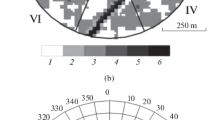Abstract
From data of meteorological stations in a city (Munich) and in a forest (Ebersberger Forst, near Munich) for the summer months 1972 mean monthly diurnal variations of the following parameters were computed: vapour pressure, equivalent temperature, effective temperature, energy consumption with respiration and hourly water requirement for saturation of the respiratory air. The results show that during the summer season forest air is bioclimatically more comfortable than city air for humans.
Similar content being viewed by others
Literatur
ABEL, H., BAUMGARTNER, A. und DONLE, W. (1972): Energieverbrauch zur Erwärmung und Wasserdampfsättigung der Atemluft. Arch. Meteor. Geoph. Biokl., B, 20: 373–400.
BAUMGARTNER, A. (1967): Ermittlung der tatsächlichen Verdunstung aus Messungen des vertikalen Wasserdampfaustausches und der Energiebilanz. Sonderheft 1967 der Gewässerkundl. Mitt., 192–195.
BAUMGARTNER, A., ABEL, H. und DONLE, W. (1972): Energetik der Atmung im Gebirge. XII. Internationale Tagung für Alpine Meteorologie, 227–230.
BÜTTNER, K. (1938): Physikalische Bioklimatologie. Akad. Verlagsgesellschaft, Leipzig.
CHANDLER, T.J. (1967): London's heat-island. In: Biometeorology 2. S.W. Tromp and W.H.Weihe (ed.). Pergamon Press, Oxford 589–597.
GIETL, G. und MAYER, H. (1976): Der Einfluss eines Fichtenbestandes auf Behaglichkeitsparameter. Forstw. Cbl., 95: 125–142.
HAGER, H. (1975): Kohlendioxydkonzentrationen, -flüsse und -bilanzen in einem Fichtenhochwald. Wiss. Mitt. Meteor. Inst. Univ. München, Nr. 26.
KING, E. (1955): Ein empirisches Schwülemass. Med. Met. Hefte, 10, 5–8.
LANDSBERG, H.E. (1972): The assessment of human bioclimate. Wrld. Meteor. Org. (Geneva), Techn. Note No. 123.
LEIBUNDGUT, H. (1975): Wirkungen des Waldes auf die Umwelt des Menschen. Rentsch Verlag, Zürich.
MAYER, H. (1975): Die effektive Temperatur unter dem Aspekt "Schwüle" in 2 m und 175 m über Grund. Arch. Meteor. Geoph. Biokl., B, 23: 147–155.
MAYER, H. und GIETL, G. (1976): Energetik der Atmung im Wald. Arch. Meteor. Geoph. Biokl., B, 24: 85–94.
MISSENARD, H. (1948): Equivalences thermiques des ambience; equivalences de passage; equivalences de sejour. Chaleur et Industrie, 24: 159–183.
PARRY, M. (1967): The urban "heat-island". In: Biometeorology 2. S.W. Tromp and W.H.Weihe (ed.), Pergamon Press, Oxford Part 2, 616–624.
SCHARLAU, K. (1943): Die Schwüle als messbare Grösse. Bioklimat. Beibl., 10: 19–23.
SPANGENBERG, W. (1951): Über die Ursachen der Schwüleempfindung. Angew. Meteor., 1: 33–35.
STRAUSS, R. (1971): Energiebilanz und Verdunstung eines Fichtenwaldes im Jahre 1969. Wiss. Mitt. Meteor. Inst. Univ. München, Nr. 22.
Author information
Authors and Affiliations
Rights and permissions
About this article
Cite this article
Mayer, H., Gietl, G. Bioklimatische Unterschiede zwischen einer Stadt- und einer Waldatmosphäre. Int J Biometeorol 20, 325–332 (1976). https://doi.org/10.1007/BF01553590
Received:
Issue Date:
DOI: https://doi.org/10.1007/BF01553590




